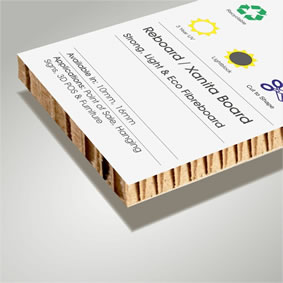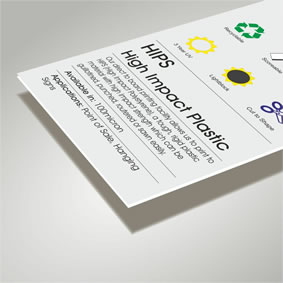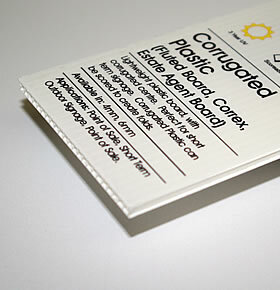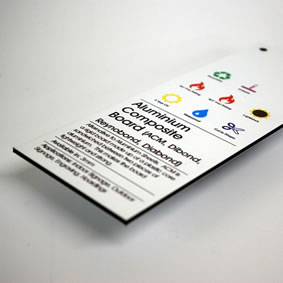This Blog is about PVC Foam Board and It's alternatives...
Personally, I think carbon offsetting against plastics like PVC is borderline unethical. PVC may well become the asbestos of the future, not because it harms us directly but because it has very detrimental long-term effects on our planet.
To overcome this we are increasing our range of alternatives to PVC and promoting other sustainable products.
Here’s the low down on PVC:
What is Foam PVC used for in Signage and Display Graphic Printing?
Foam PVC (Polyvinyl chloride) sheets are commonly used in the signage and printing industries for creating high-quality, durable and cost-effective signs, displays, and advertising materials.
Foam PVC sheets are lightweight and easy to handle, making them an ideal material for creating indoor and outdoor signs, exhibition displays, point of sale materials, and other marketing materials. They are also highly resistant to weather, UV radiation, and moisture, making them suitable for outdoor use.
Foam PVC sheets can be easily cut, routed, and fabricated to any shape and size, making them highly versatile. They can also be easily printed on using a range of digital and traditional printing methods, including screen printing, UV printing, and digital direct-to-substrate printing.
In summary, Foam PVC sheets are used in signage and printing for their durability, versatility, and cost-effectiveness, making them a popular choice for creating high-quality marketing materials that can withstand the elements and stand the test of time
What is the Environmental Impact Caused by using Foam PVC?
The use of foam PVC in the signage and printing industry can have negative environmental impacts, mainly due to its composition and disposal.
Foam PVC is made from petroleum-based materials, which are non-renewable resources. The production process of PVC also generates significant greenhouse gas emissions, contributing to climate change. Additionally, the manufacturing of foam PVC involves the use of chemicals that can be harmful to the environment and human health, such as chlorine and dioxins.
Furthermore, the disposal of foam PVC can pose a significant environmental problem. When disposed of in landfills, foam PVC can take hundreds of years to degrade, contributing to the accumulation of non-biodegradable waste. When incinerated, PVC can release toxic chemicals into the air, contributing to air pollution.
To minimize the environmental impact of foam PVC, it is essential to consider alternative materials or recycling options. Some manufacturers are now producing PVC-free materials or using recycled PVC in their products. Recycling foam PVC can also be an effective solution, as it can be melted down and reprocessed into new products. It is essential to dispose of foam PVC responsibly by recycling or using specialized disposal facilities that can handle this material.
What are the Alternatives to using Foam PVC for Signage and Display Graphics?
There are several alternative materials to foam PVC that can be used for signage and display graphics. Some of the most common ones include:
- Corrugated plastic: Also known as Coroplast, this lightweight and durable material is made of polypropylene and is an excellent alternative to foam PVC. Corrugated plastic is waterproof, weather-resistant, and easy to cut and shape, making it ideal for outdoor and indoor use.
- Recyclable paper-based boards: These boards are made from recycled paper and are a more eco-friendly alternative to foam PVC. They are lightweight, sturdy, and available in a range of thicknesses, making them suitable for a wide variety of applications.
- Acrylic: Acrylic, also known as plexiglass, is a clear plastic that is often used as an alternative to glass in signs and displays. It is durable, lightweight, and easy to cut and shape, making it a popular choice for indoor and outdoor signage.
- Aluminum composite panels: These panels are made from a combination of aluminum and a plastic core and are an excellent alternative to foam PVC. They are weather-resistant, durable, and easy to cut and shape, making them ideal for outdoor and indoor applications.
- Natural materials: Natural materials such as wood, bamboo, or cork can be an excellent alternative for more sustainable signage and display graphics. These materials are biodegradable, renewable, and can add a unique touch to any display or sign.
In summary, there are several alternative materials to foam PVC that are available and can be used for signage and display graphics. These materials offer different benefits such as sustainability, durability, and ease of use, making it possible to choose the most suitable material for a particular application.
We have many alternatives to PVC and it is best to speak to a real human about this...
Call us on 0330 380 0172
Take care everyone and I hope this was useful!
















































































































































Please login to post a comment.